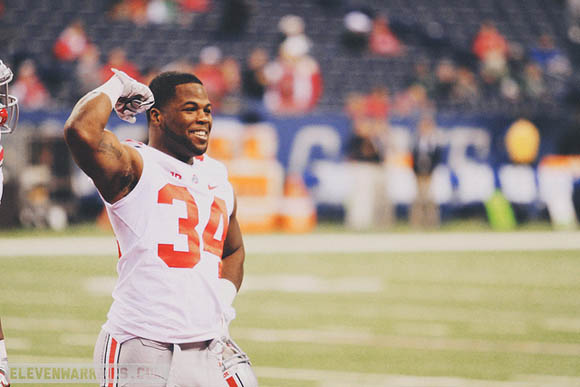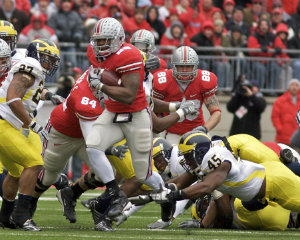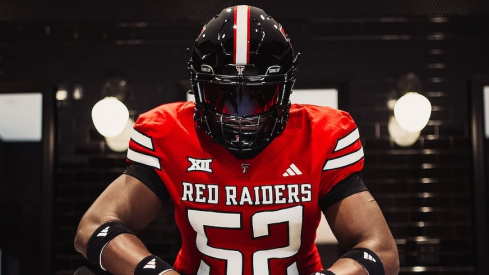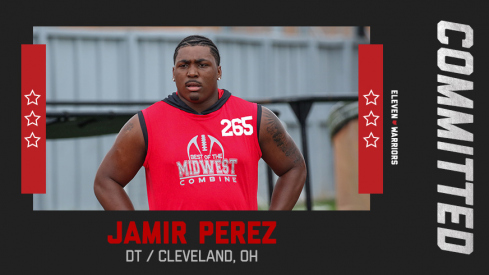
The Michigan State loss has dampened our perception of an otherwise legendary season for many individual Buckeyes – and none moreso than Carlos Hyde.
Hyde's season was among the most productive in the history of Ohio State running backs despite only playing in ten games. It's notoriously difficult to separate running back yards from offensive line yards statistically, but the combination was the Hemi V-8 engine for this record-setting offense.
From Hyde's nomination as Big Ten Player of the Year:
Earlier this week, Hyde was named the Big Ten's Ameche-Dayne Running Back of the Year. The senior from Naples, Fla., leads the Big Ten in rushing with 143.3 yards per game along with 14 touchdowns, including 156.1 yards per game in Big Ten play. Hyde, who has rushed for 589 yards and seven touchdowns in the last three contests, also was named first-team all-conference by both the coaches and the media. With 1,290 yards, he became the first running back for an Urban Meyer-coached team to rush for 1,000 yards in a season. He rushed for at least 100 yards in each of the last seven games, including two 200-yard performances.
While the Buckeyes prepare for the Orange Bowl, we have ample time to appreciate Hyde's year, especially in comparison to the last two elite OSU running backs, Beanie Wells and Maurice Clarett.
It's notoriously difficult to compare players across different years and teams. Different offensive lines, play calls, and other offensive threats on the team complicate simple comparisons of basic statistics. Then there's the issue of more advanced statistics being unavailable that far in the past, as Sabermetric-style statistics for college football are a relatively new phenomenon.
Regardless, I attempted to do some basic comparisons between Hyde, Beanie, and Clarett to assess their overall rushing numbers, their value to the the team, and their performances against Michigan in the best years of their respective careers (this year for Hyde, 2007 for Beanie, and Clarett's only season in 2002).
Basic Numbers
| Player | ATT | Yards | YPC | TD | ATT/G | Yards/G | RECEIVING |
|---|---|---|---|---|---|---|---|
| Hyde | 183 | 1408 | 7.7 | 14 | 18.3 | 140.8 | 14/108 |
| Wells | 274 | 1609 | 5.9 | 15 | 21.1 | 123.8 | 5/21 |
| Clarett | 222 | 1237 | 5.6 | 16 | 20.2 | 112.5 | 12/104 |
Each of the three running backs could be counted on for close to six yards a carry and approximately 20 carries per game, but Hyde rumbled for almost 7.7 yards per carry and an extremely high running back success rate in Meyer and Herman's running back-friendly offense. Beanie was used (and needed) far more than either of the other two running backs.
Clarett and Hyde both got involved in the passing game, if only with one or two receptions per game.
Team Players
| Hyde | Wells | Clarett | |
|---|---|---|---|
| % Points Responsible | 16% | 26% | 31% |
| % Yards Responsible | 21% | 31% | 24% |
El Guapo never stood a chance against the other two in these categories because 1. the team played three games (against cupcake defenses) without him, and 2. because the offense had other extremely potent weapons as well (Braxton, Philly, Smith, Wilson).
Interestingly, Hyde and Clarett were similar in the percentage of total offensive yards responsible for, but differed widely in percentage of points responsible for. Despite missing three games and his offense producing nearly 2,000 more total yards during the year, Hyde and Clarett had fairly similar levels of yardage productivity.
Finally, it's hard to deny just how critical Beanie Wells was to the 2007 team after accounting for a fourth of total points and nearly a third of total yardage. Only Maurice "Rasta" Wells and the freshmen Brandon Saine and Boom Herron backed up Beanie in '07.
It's Michigan That Matters
If you're a traditionalist, this may be the only category that matters:
| Player | ATT | Yards | YPC | RBSR | TD |
|---|---|---|---|---|---|
| Hyde | 27 | 226 | 8.4 | 74% | 1 |
| Wells | 39 | 222 | 5.7 | 54% | 2 |
| Clarett | 20 | 119 | 6.0 | 50% | 1 |
 All three put up their best games against Michigan
All three put up their best games against MichiganAll three were verifiable Wolverine killers. Hyde was the most productive (setting the bar for most rushing yards against Michigan in The Game) and efficient, Beanie was the battering ram with 39 carries, and Clarett the youngest and a crucial receiving threat as well.
Conclusions
There are some obvious impediments to a satisfying conclusion for this comparison: Hyde is a senior while Beanie was a sophomore and Clarett a freshman, Hyde's offensive line was among the best in college football, none of these statistics are opponent-adjusted or "advanced" in any way, and Hyde had the benefit of two of the brightest football minds directing his offense. The only helpful clue we have for strength of schedule is that Sagarin has the Buckeye schedule 57 in 2013, 53 in 2007, and 30 in 2002.
However, all three came up big in their biggest games. Beanie hit 222 against Michigan and 146 in the national championship, Clarett had 119 against Michigan (though just 47 against Miami's incredible rush defense), and Hyde had 226 against Michigan and 118 against the Spartans. Two of the three led the Buckeyes to national championship appearances, while Hyde (and a pass defense) was one game away from doing the same.
So which Buckeye running back would you take if forced to choose one for a single game? It's easy to make an argument for any one of them based on the numbers alone. Regardless, Hyde has a case to be included amongst the great running backs in Ohio State history.

